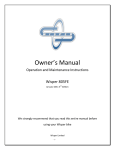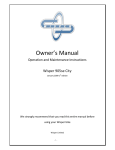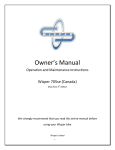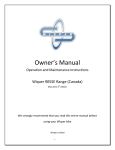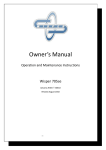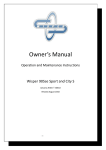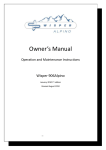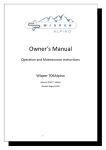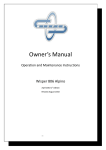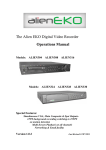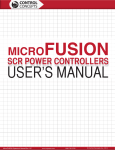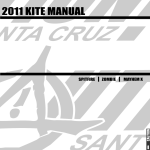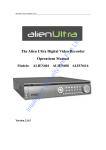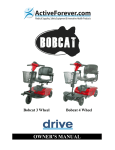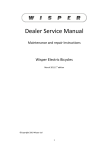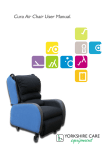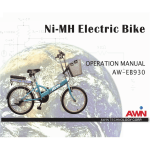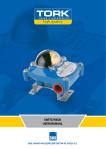Download 806fe Folding Bike
Transcript
Owner’s Manual Operation and Maintenance Instructions Wisper 806fe April 2009 1st edition We strongly recommend that you read this entire manual before using your Wisper bike Wisper Limited -1- User Guide Introduction Page 3 Part 1 Caring for your Wisper bike and pre use checks 1 2 3 4 5 6 7 8 Before you set off for the first time Before each use Battery care Recharging your battery Water Maintenance and adjustments Technical specifications and performance Simple trouble shooting Part 2 Controls and Equipment 9 10 11 12 13 14 15 16 17 18 Battery on off and battery lock Capacity indicator Gear shifters Pedelec mode Throttle Brakes The front connection box Rims and spokes Chain and drive wheel Derailleur Page 4 Page 5 Page 5 Page 6 Page 6 Page 6 Page 8 Page 8 Page 9 Page 9 Page 9 Page 9 Page 9 Page 10 Page 11 Page 11 Page 11 Page 11 Warranty Page 12 Service contacts Page 13 -2- Introduction Thank for choosing a Wisper electric bicycle. By making the decision to use an electric bike you are helping to safeguard our environment by saving our planet’s precious resources and reducing carbon pollution. Before you use your Wisper bike it is important that you read this manual carefully. If there is anything you do not understand completely please contact your retailer. Please observe traffic regulations, and don’t lend your bicycle to anyone who is unfamiliar with it. The bicycle can only legally be used on the road by a person aged 14 years or older. We strongly advise you to always wear a cycle helmet when using your bicycle and if you are unfamiliar with cycling to attend a cycle proficiency course prior to using it. Your Wisper Works 806fe is not toy and should be considered a serious mode of transport. As with all bicycles it is important that you stay within safe limits, if you feel as if you are traveling too quickly for the road conditions you probably are, so slow down. High speed will increase forces in the case of an accident and increase the possibility of injury. Test your brakes prior to using the bike every time you use it and remember the bike will not stop as quickly in wet or icy conditions as it would on a dry road. Before you use the bike for the first time you must make absolutely certain that it has been correctly built. You can do this by either taking it to your nearest cycle engineer or if you are proficient in cycle mechanics inspecting it yourself. In particular you must make sure that the pedals, saddle, handle bars and any self assembly items have been correctly fitted. NEVER drink alcohol and ride your electric bike. The use of alcohol greatly reduces reflexes and limits your ability to ride safely. Even a very small amount of alcohol will limit your ability to be safe on the road. When you need to replace your battery please either dispose of it properly or preferably send it back to us or your supplier and we will make sure it is properly recycled. Happy cycling! Wisper Ltd -3- Part 1 Caring for your Wisper bike and checks Although your Wisper bike has been thoroughly tested prior to delivery, it is very important that you check the bike again before its first use. Equally important are frequent and regular spot checks, they will protect you and your Wisper bike. Please read this manual carefully. Only on full understanding of all the functions of this electric bicycle should you attempt to use it. Your retailer may have assembled your bike for you if not you will find fitting instructions on the Wisper website www.wisperbikes.com 1 Before you set off for the first time 1.1 1.2 1.3 1.4 1.5 1.6 1.7 1.8 2 Check the handle bars and handle bar stem are properly tightened Check all other nuts and bolts and fixings are properly tightened, pay particular attention to the motor fixings, side kick stand, yoke and steering head bearings Check brakes and brake isolators are functioning properly Check tyre pressures are correct and tyres are not damaged Check reflectors and lights if fitted are functioning properly Make sure battery is fully charged Load battery into your bicycle’s rear carrier and turn on the power on/off button. Lock the battery into the rear carrier to ensure the battery’s output connection is always connected properly. Remember to validate your warranty by visiting www.wisperbikes.com/mywarranty and filling in your details. Before each use It is important you perform a quick check of your bike every time you use it, checks should include the following, if you find any damage or problems do not use the bike until the problem has been solved or you have had the faulty item checked by a bike mechanic or your retailer. 2.1 2.2 2.3 2.4 2.5 Check tyres for any visible damage Check tyre pressures Check for any lose nuts bolts or fixings Check brake functions Check electronic functions -4- 2.6 2.7 Check reflectors are in place and lights are working Check your battery for any visible signs of damage 3 Battery care 3.1 Before you use the battery for the first time it is best to give it a full deep charge for 12 hours. To fully condition your new battery give it complete deep charge/discharge cycles for the first three charges. This is achieved by charging your battery for 12 hours and then using the bike until the battery is completely drained. After this “conditioning” process you can then charge and discharge the battery as and when you require for long or short periods If you are going to leave your battery uncharged for more than eight weeks it is best left half charged. You should then re charge it every four weeks for two hours to keep it in top condition Before setting off on any journey it is always better to have a fully charged battery Do not expose the bicycle or battery pack to fire, heat sources, acid or alkaline substances When leaving your bicycle during hot weather always leave in a shaded well ventilated area For best results always recharge the battery at room temperature Before unloading the battery make sure it is turned off at the key and unlocked, pull the battery box from the rear carrier housing. Please refer to the picture If your battery is damaged or appears to be overheating for any reason immediately return it to your retailer for advice and a safety check 3.2 3.3 3.4 3.5 3.6 3.7 3.8 4 Recharging your battery 4.1 First connect the output connector plug with the battery (Please refer to the recharge point shown), then connect to the mains. Make sure the charger is turned off and connect the charger to your battery then turn on the charger. Red and yellow lamps on the charger indicate the battery is charging, when the yellow light turns green the battery fully charged. Always turn off the charger and disconnect from the mains after charging. Always disconnect the charger from the mains before disconnecting the charger from the battery. It is possible that the battery will take up to 12 hours to charge on the first three charges. -5- 4.2 4.3 Always charge the battery always in a well ventilated area. Do not leave the charger connected to the mains when not in use. 5 Water 5.1 5.2 Your electric bicycle is rain and splash proof and can be used in all weathers. The electrical components of the vehicle, such as motor, battery, and controller, must not be submerged in water. 6 Maintenance and adjustments 6.1 IMPORTANT! Do not attempt to open the casings of the battery, motor or controller it could be dangerous and all warrantees will become void. If you experience a problem contact our service department or your retailer. Wheel spokes should be adjusted after 300 miles riding. Saddle tube should never be raised beyond the maximum indicated by a safety line around the tubes. The recommendation of the torque on the nuts as follows: 6.2 (A) Front axle nuts. 70N.M (B) Back axle nuts. 46N.M (C) Handlebar stem expander bolt. 18 to 20N.M (D) Seat pillar clamp nut/bolt. 5-8N.M (E) Brake cable anchor bolt. 5N.M (F) Brake centre bolt. M6:11N.M (G) Seat clamp nuts. 24N.M (H) Cotter pin nuts. R:42N.M (I) Gear shifter nuts. 4N.M (J) V brake caliper nuts. 10N.M (K) Rear carrier nuts. 8N.M (L) Mudguard bracket nuts. 8N.M L: 46N.M Other nuts/bolts torque depends on their size. M4:2.5-4.0N.M M5:4.0-6.0N.M 6.3 6.4 6.5 6.6 M5: M6:6.0-7.5N.M Your bike has a rear derailleur that will automatically tension your chain. However if the chain becomes loose or frequently comes off the drive wheel, you can easily adjust the chain tension by loosening the rear axle nuts slightly, and adjusting the tension bolts. Make sure that the chain runs freely and re-tighten the axle nuts. The brake leavers should lock the wheels when compressed half way between their open position and touching the handle bars. When they need adjusting please do according follows suggestions. Warning: Handlebar hand grips or tube end plugs should be replaced if damaged, as bare tube ends have been known to cause injury. Warning: Replacement forks must have the same rake and same tube inner -6- diameter as those originally fitted to the bicycle. IMPORTANT braking distances increase on wet or icy roads. 6.7 Lubrication: 6.7.1. Once a month to lubricate all pivot points on derailleur, derailleur pulleys with chain lube. 6.7.2. Every three months lubricate the brake lever pivots, the gears and chain with light oil and the brake bushes (not the rubber brake shoes or disc) with a little grease. 6.7.3 Once a year, have your dealer re-grease the bottom bracket bearings, headset bearings, wheel bearings or you lubricate pedal axles where they thread into the crank arms, handlebar stem by yourself. 6.8 Recommended tools for proper maintenance: Torque wrench with Nm gradations 2, 4, 5, 6, 8 mm Allen wrenches 9, 10, 15 mm open-end wrenches 15 mm box end wrench Socket wrench, 14, 15, and 19 mm socket T25 Torque wrench No. 1 Phillips head screwdriver Bicycle inner tube repair kit, tyre pump 7 Technical specifications & performance Type Performance Assisted range Maximum speed Weight with battery Maximum load Wisper Works 806fe (with 75kg 165lb rider) Up to 40km 25kph (15.5mph) 19.6kg max 130kg (240kg) Battery specifications Cell Type Capacity Rated voltage Advanced Environmental Panasonic Lithium Cells 9Ah 24V Main Controller specifications Low voltage safeguard 21.5V Overload current safeguard 14A Main hub motor specifications Motor type Hi speed brushless Rated power Aus NZ 200W / Europe 250W Rated voltage 24V Charger Lithium 115 to 230V 24V fan cooled -7- 8 Simple Trouble shooting Problem Possible reasons Trouble shooting Top speed too slow 1. Low battery voltage 2. Damage to motor driveline 1. Recharge battery fully 2. Call service Power on but motor not working 1. Battery not connected position 2. Fused 3. Motor connection damaged 1. Re install battery 2. Replace fuse 3. Call service Driving shorter distance per recharge 1. Tyre pressure too low 2. Undercharge or charger fault 1. Check pressures 2. Recharge completely or have charger inspected 3. Replace battery 3. Battery capacity loss or damage Part 2 Controls and Equipment In this section we will describe the functions and any specific maintenance needed on all the main controls and ancillary equipment. 9 Battery on off and battery lock 9.1 Your Wisper bike has 1 key. This key is for locking the battery into the bike. Please keep a careful note of the key number as we cannot replace it without this number should it become mislaid. The battery is connected to the electrical system on the bike automatically when you push the battery into the rear carrier housing. To turn on the bikes electrical system, switch the on/off button in the battery box to on, to turn off the bikes electrical system, switch the on/off button in the battery box to off. (Please refer to the picture) After the battery has been turned on the bike is ready for use. The battery box capacity indicator is on the handle bar for ease of use. Assistance from the battery is then available. 9.2 9.3 -8- 9.4 9.5 9.6 To lock the battery into the bike frame turn the key clockwise the locking bolt holds the battery, if you wan to unlock turn the key anti clockwise while the key at lock position. Read 3 and 4 for battery care and advice on charging at the beginning of this manual. The battery can be charged either on or off the bike. To remove the battery first turn off the power by switching the on/off button. Unlock the battery and pull out from the rear carrier housing. On the handle bars 10 The battery capacity box 10.1 When the battery is switched on the lights on the capacity indicator on the handle bars will illuminate showing the battery capacity available. When the battery is switched off the lights will go out and you will not get any assistance from the battery or motor. The bike is then an unpowered push bike. 11 Gear shifters 11.1 806fe has 16 gears, 2 front chain drives (34 and 50 teeth) and 8 rear sprockets (11 to 30 teeth). The front shifter will move the chain between the high gear chain drive H and the low L. (Please refer to the picture). The rear shifter will move the chain from the highest gear to the lowest by simply moving the lever from left to right. 12 Pedelec mode 12.1 When you first ride your Wisper bike you will notice that after one turn of the pedals the motor will start working assisting you ride the bike by adding power to the front wheel. This is the standard or pedelec mode, to continue using the pedelec mode you must keep turning the pedals, if you stop the motor will stop and the bike will slow to a halt. If you start pedaling again after one turn the motor will start again. 13 Throttle 13.1 No throttle is available in this bike. -9- IMPORTANT Make sure your handle bar grips are always intact, in good condition and on the bike. Uncovered handlebar tubes can be very dangerous in case of a collision. 14 Brakes 14.1 14.2 Front and Rear: V brake The brakes on your Wisper bike are fitted with cut outs which are required by law. This means that when you pull on either the back or front brake lever the motor immediately stops working. Full details of how to adjust and maintain your brakes: Once a month, inspect brake pads for wear. If the grooves in the braking surface are less than 2 mm deep, replace the pads. V brake: 14.3.1. Use 5mm Allen key to loosen bolt A, then take the cable out. Use 5mm Allen key to loosen bolts C (right & left), then take the spacers and washers out 14.3.2. Install new brake pads, then with both pads pressed against the wheel rim, ensure that distance B (in the diagram) does not exceed 65mm. To decrease distance B, exchange wide & narrow spacers on each brake pad. Before finally tightening brake pads, make sure they are aligned correctly on the rim, and there is a gap of 1mm between the top of the rim and the top of the pad. Hold each pad against the rim (one at a time) & tighten bolt C. Finally tighten to 6-8N.M 14.3.3. Insert cable into bolt A, slot cable guide pipe into holder and fit protector over the guide pipe end. Set cable in bolt A so that combined pad/rim clearance (the gaps from left pad to left rim surface and from right pad to right rim surface) is 2mm, then tighten “A” bolt. Finally tighten to 6-8N.M. Balance brake arms by turning screw D. Depress brake lever a few times while checking to see that tension is equal for both arms. Pad/rim contact should occur at the same time each side. Clearance should be 1mm each side. Do not set tensions too high. 14.3.4. Re adjusts pads so they are properly aligned (see step 2), as tension adjustment will probably have altered the original pad alignment. 14.3.5. Installing brake pads. 14.3.5.1.Position each pad on an opposite side of the holder so that two breaking surfaces are facing each other. 14.3 - 10 - 14.3.5.2. Take care not to touch the braking surfaces, push the pads in the holder together and insert into the caliper so that the protruding lip with the retainer bolt hole is aligned with the bolt hole on the caliper. 14.3.5.3. Insert the retainer bolt and tighten it with a 3mm Allen wrench, finally tighten to 3-5N.M 15 15.1 The front connection box The front connection box allows for the easy removal for repair or replacement of any of the electronic components on the handle bars. 16 Rims and spokes 16.1 It is essential to get your spokes checked and tightened after 300 miles or 500km. This is a free service provided by your supplier. If this service has not been undertaken at the correct time this may cause damage to the wheels and spokes that will not covered under our guarantee. 17 Chain and drive wheel 17.1 17.2 Lightly oil with bicycle chain oil the chain at least once a month. Because your bike has a rear derailleur the chain will be automatically adjusted. 18 Derailleur 18.1 Full details on how to adjust and maintain your derailleur can be found on our website www.wisperbikes.com Electric bikes, Manuals. - 11 - Warranty Repair or replacement of components IMPORTANT To validate this Warranty the retail customer must register the bike at www.wisperbikes/mywarranty within 14 days of purchase. Only use this product in accordance with this user manual. We offer a limited warranty of on the following items. 1 The main frame Six years 2 Gears, bearings, motor shell, hub motor, front forks Two years 3 Handle bar controls, brakes (excluding brake shoes and pads) One year 4 Controller and Charger Two years 5 Battery casing, battery leak, battery capacity step-down more than 30% One year 6 Paintwork (excluding deliberate or accidental damage) Two years 7 Front and rear axle, flywheel or chain wheel One year 8 Electro plating, on wheel rims, rack and kickstand Six months 9 Other cases that render the bike unsafe to use. By negotiation 1. If the product has a quality fault within 15 days of delivery the part will be repaired or replaced or in exceptional circumstances we may replace the whole vehicle. 2. The period of assurance shall commence from the day delivery was made to the retail customer, or from the day the retail customer collected the bike from the retailer. 3. To validate this Warranty the retail customer must register his / her bike at www.wisperbikes/mywarranty within 14 days of purchase. Exceptions to Limited Warranties 1. Damage resulting from misuse, not maintaining the vehicle or not following the guidelines within this user guide. 2. Accidental or deliberate damage. 3. Damage due to private repair or alteration by user or unauthorised service centre. 4. Failure to produce invoice or proof of purchase. 5. Spare parts and components worn in normal use. 6. Failure to register your bike at www.wisperbikes/mywarranty within 14 days of purchase. - 12 - It is essential to get your spokes checked and tightened after 300 miles / 500km. This is a free service provided by your supplier. If this service has not been undertaken at the correct time this may cause damage to the wheels and spokes that will not covered under our guarantee. Service through Your retailer or Wisper Ltd 10 Oakenbrow Sway Hants SO41 6DY Tele: 01590 681553 Mobile: 07977 185830 [email protected] www.wisperbikes.com Copyright January 2009 Wisper Ltd - 13 -













